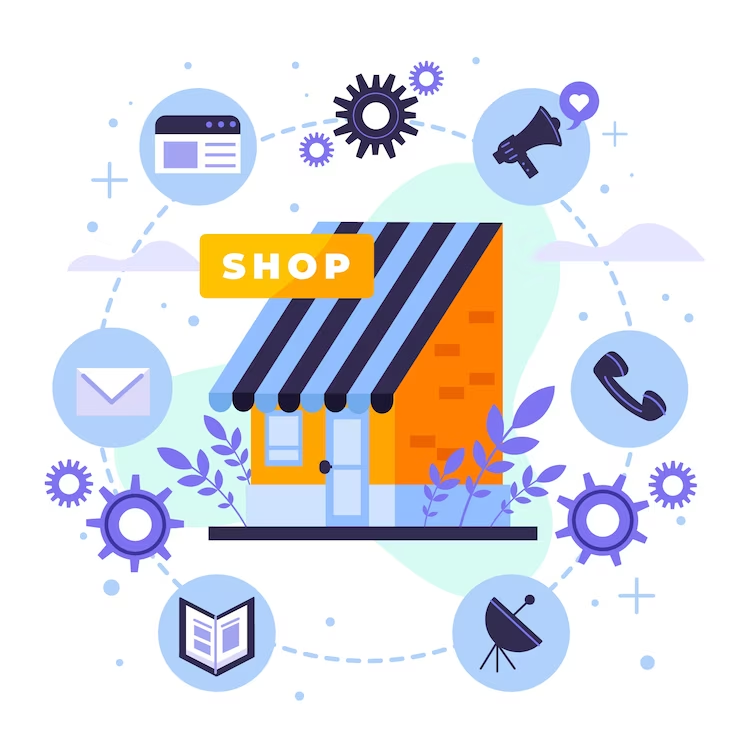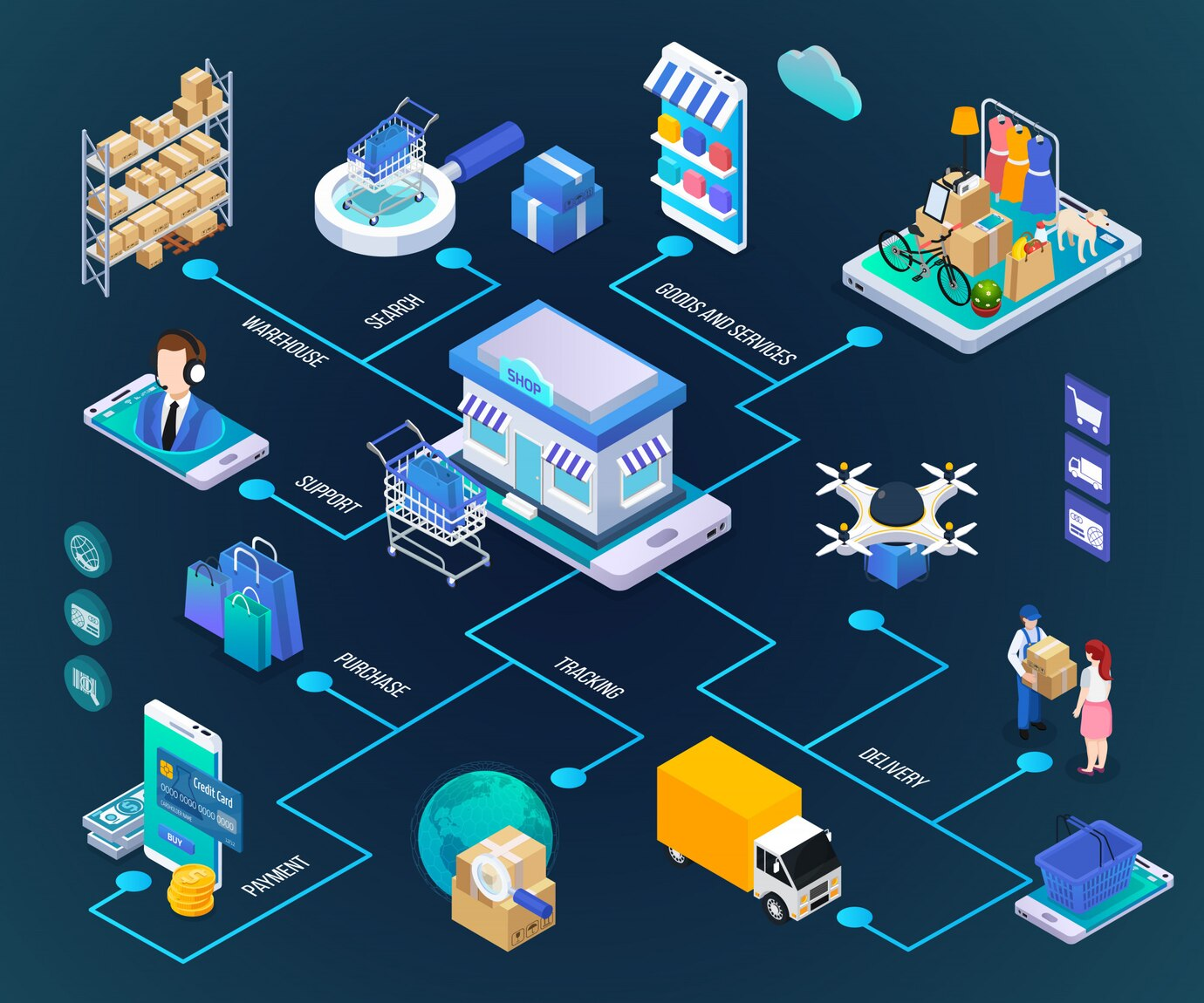Omnichannel E-Commerce: How to Build a Successful Strategy?

In today’s fast-paced digital world, the retail landscape has evolved significantly. With the rise of e-commerce, businesses are constantly searching for innovative ways to engage with customers and drive sales. One such approach that has gained immense popularity is omnichannel eCommerce. But what exactly is omnichannel?
What is omnichannel commerce?
Omnichannel commerce is a comprehensive sales approach centered on delivering seamless customer experiences across various channels. The aim is to ensure consistency at every interaction point, whether customers are shopping online via mobile devices, laptops, or in physical stores.
Statistics from Harvard Business Review indicate that 73% of customers utilize multiple channels during their purchasing journey. Additionally, findings from The State of Commerce Experience reveal that nearly half (44%) of B2C buyers and 58% of B2B buyers consistently or frequently research products online before visiting brick-and-mortar stores. Even while in-store, they continue their research online.
These e-commerce trends indicate that customers typically make purchases only after gathering extensive information from diverse sources to inform their decisions.
Therefore, an effective omnichannel strategy prioritizes the overall customer experience, rather than focusing solely on individual channel interactions.

Differences Between Omnichannel and Multichannel
It is important to note that omnichannel and multichannel are not interchangeable terms. While they both involve selling products through various channels, there is a significant difference in their approach.
| Aspect | Omnichannel Approach | Multichannel Approach |
|---|---|---|
| Focus | Dedicated to delivering a seamless and consistent customer experience across all channels. | Involves utilizing multiple independent channels to reach customers. |
| Customer Journey | Emphasizes creating a consistent and unified customer journey that spans various touchpoints. | Involves a fragmented customer journey, with each channel operating separately. |
| Integration | Involves integrating and coordinating different channels to ensure a cohesive customer experience. | Channels operate independently, with less integration between them. |
| Data Sharing and Analysis | Centralizes customer data, enabling a comprehensive view of customer behavior and preferences. | Data sharing is limited, potentially resulting in separate customer data silos. |
| Consistency | Ensures consistent branding, messaging, and user experience across all channels. | Branding and messaging might not be consistent across different channels. |
| Customer View | Offers a unified customer view, allowing businesses to understand interactions across all touchpoints. | It might be difficult to understand the whole picture if customer views are channel-segmented. |
| Personalization | Enables high levels of personalization by utilizing data from all channels to tailor interactions. | Personalization efforts might vary by channel, leading to inconsistent experiences. |
| Flexibility | Provides flexibility for customers to interact seamlessly across channels based on their preferences. | Offers limited flexibility, as interactions are often constrained to specific channels. |
| Operational Efficiency | Can result in higher operational efficiency due to centralized data and coordinated efforts. | Operational efficiency might be lower due to duplicated efforts across independent channels. |
| Complexity | Can be more complex to implement due to the need for integration and consistency across channels. | Generally less complex to implement, as channels can be managed separately. |
| Examples | A customer might start shopping on a mobile app, add items to their cart, and complete the purchase on a desktop website, with the cart and order history synchronized seamlessly. | A business might use a brick-and-mortar store, a social media page, a website, and an email campaign to reach customers, but each channel operates without real-time integration. |
Ultimately, the choice between an omnichannel and a multichannel approach depends on your business’s goals, resources, and the preferences of your target audience. While omnichannel offers a more integrated and seamless customer experience, multichannel provides flexibility in reaching customers through different platforms.
It’s important to carefully evaluate your business needs and customer expectations to determine the most effective strategy for your situation.
Advantages of Embracing Omnichannel eCommerce
Enhanced Customer Experience
Customers today prioritize a seamless, unified experience across various touchpoints. As the number of touchpoints increases, the demand for smooth integration from one touchpoint to another becomes imperative. Whether it’s through social ads, email newsletters, mobile push notifications, chatbot interactions, or face-to-face discussions with store staff, customers expect interactions to feel natural and consistent.
By breaking down channel barriers, businesses empower consumers to engage in a manner that suits them best, ultimately enhancing overall satisfaction.
Increased Sales and Traffic
Although transitioning to an omnichannel sales strategy requires effort, it proves highly rewarding. A study involving 46,000 shoppers demonstrates that omnichannel customers tend to spend more than those utilizing a single channel.
Moreover, the more channels they engage with, the higher their spending in-store. Notably, customers utilizing four or more channels spend an average of 9% more compared to those restricted to a single channel.
Better Customer Loyalty
Omnichannel customers not only spend more but also exhibit greater loyalty to brands. The same study from Harvard Business Review indicates that within six months following an omnichannel shopping experience, these customers recorded 23% more repeat shopping trips to the retailer’s stores.
Additionally, they are more inclined to recommend the brand to family and friends compared to single-channel users. By prioritizing customer loyalty over traditional marketing tactics, such as discount coupons and mid-sale campaigns, businesses can solidify their brand position and foster long-term customer relationships.
Improved Data Collection
Businesses adept at tracking customer behavior across various channels can deliver more personalized experiences. The omnichannel approach enables retailers to glean insights into customer preferences, enabling them to tailor content and offers that drive engagement across both online and physical stores. This enhanced understanding of customer behavior facilitates targeted marketing efforts and fosters increased consumer engagement and loyalty.
Learn more: 7 Omnichannel Marketing Strategies You Should Implement
How to Build an Omnichannel Ecommerce Strategy?
Having thoroughly explored the disparities between omnichannel and multichannel ecommerce, along with the primary advantages of the latter, let’s delve into the essential components for constructing a robust omnichannel strategy.
Step 1: Customer Journey Mapping
While every customer journey varies from discovering a brand to purchasing a product to advocating for it on social media, it’s valuable to begin delineating the potential paths they may take.
A suitable starting point involves defining the distinct stages of customer purchase behavior, encompassing problem recognition, interest, research, and purchase.
Once these stages are outlined, it becomes possible to analyze why customers engage at each point and identify their corresponding objectives, be it research, comparison, or purchase facilitation. For instance, younger customers might discover the brand through Instagram, whereas older demographics may rely more on Google search results.
Subsequently, integrating this information enables the mapping of the customer journey. Each touchpoint along this journey represents an opportunity to engage with customers in a manner that enhances their experience, increasing the likelihood of conversion. Crucially, recognizing the importance of every channel within the strategy is paramount. To help guide your efforts, you might consider utilizing a free customer journey map template to effectively track and analyze each touchpoint across demographics and channels.
Step 2: Build Audience-Engaging Content
Utilizing the customer journey map as a guide, you can begin brainstorming tailored content that resonates with the platform it’s intended for and facilitates the achievement of your objectives on those platforms.

Here are some strategies to enhance content engagement:
Capture stunning product shots of a new product line for Instagram to generate excitement and anticipation among customers, keeping them informed about the upcoming launch.
Produce behind-the-scenes footage for TikTok, incorporating trending audio and showcasing intriguing aspects of the production process to captivate viewers.
Craft compelling email subject lines to conduct A/B testing for your upcoming email marketing campaign, aiming to pique recipients’ interest and improve campaign effectiveness.
Regardless of the content type, ensure that all produced content aligns with the customer journey and addresses customer goals effectively.
Step 3: Choose Appropriate Customer Engagement Tools
This is not the moment for arbitrary decisions or relying solely on the popularity of certain platforms. Instead, it’s about leveraging your understanding of your customers, examining your customer personas, and aligning them with the demographics of various platforms to discover the optimal match(es).
These are the tools that can enhance the omnichannel customer experience across various touchpoints.
-
Chatbots: Utilize chatbots to engage customers round the clock and deliver immediate responses to straightforward inquiries.
-
Live Chat: Provide real-time assistance for sales or support-related inquiries through live chat, thereby enhancing customer satisfaction.
-
Visual Interaction Tools: Employ tools like co-browsing and video chat to engage in direct conversations, facilitating quicker issue identification and personalized solutions.
By incorporating digital tools and customer interaction strategies, you can deliver prompt responses and effective solutions. This, in turn, enables you to fortify relationships with existing customers and cultivate brand loyalty.
Step 4: Clarify Channel Objectives
While our focus has primarily been on utilizing various channels for sales – a cornerstone of omnichannel strategy – it’s crucial to recognize that not every channel needs to serve as a direct sales platform.
After identifying the channels you intend to engage with, delineate the specific purpose for each one, whether it involves sales or other objectives.
Assigning a purpose to each channel also entails a commitment to crafting tailored content for each platform, rather than simply reposting identical content across all channels.
Adopting a uniform approach across channels fails to yield consistent results. For instance, consider a scenario where a B2B eCommerce company shares content on Twitter, Facebook, and LinkedIn without adapting the caption or adjusting the hashtags accordingly.
Beyond adhering to platform-specific content guidelines, it’s imperative to acknowledge variations in how your audience engages with each platform. Your content should align with their expectations for each channel.
Given the distinct nature of each channel, its users, and their expectations, maintaining uniformity in content across platforms is counterproductive.
Step 5: Ensure Mobile Compatibility for Your Website

Regardless of whether you conduct sales on your website or not, ensuring it is optimized for mobile devices is imperative. Every visitor, whether a customer or not, should encounter an experience tailored to their mobile usage.
An efficient mobile website boasts intuitive navigation, distinct and clearly labeled sections, accessible buttons, and a user-friendly search bar. The goal is to enable users to swiftly and effortlessly locate desired information.
Step 6: Embrace Omnichannel Approach Across Every Aspect
The primary misstep businesses make in implementing an omnichannel strategy is solely focusing on sales. While sales are undoubtedly vital, every facet of your business should adopt an omnichannel approach.
Today, customers readily pose product inquiries via various platforms, such as commenting on a brand’s Instagram post. Is your customer service team equipped to handle queries not only through the website but across all channels?
Moreover, seamless transition across platforms is paramount. For instance, when a potential customer adds an item to their cart via Facebook, they should seamlessly find it in their cart when transitioning to your mobile website. Recognizing customers across platforms is essential.
Omnichannel integration extends to all aspects of your business: customer support, marketing campaigns, website functionality, automation tools, social media interactions, and every other facet of operations.
Step 7: Implement Comprehensive Data Analytics Integration

To effectively leverage analytics and customer data, integration across all channels is imperative – a recurring theme you’ve likely encountered. With integrated analytics spanning all channels, you can continuously refine customer personas and develop more informed customer journeys.
Step 8: Conduct Continuous Testing
As always, this isn’t a “set it and forget it” scenario; very little in the business realm is. Instead, strive to implement changes effectively, address any obstacles encountered along the way, and once you’ve established a level of comfort, initiate iterative improvements.
Evaluating alternative methods against your current practices is crucial for determining their efficacy. Testing remains pivotal in ensuring your strategies are optimized to their fullest potential.
Tips for launching an omnichannel commerce strategy
You won’t achieve a seamless customer journey overnight; it’s an ongoing evolution, necessitating a flexible omnichannel commerce strategy. Here are some strategies for refining your approach:
Understand Customer Shopping Preferences
Selecting the appropriate omnichannel commerce platform is paramount to the success of your strategy. Combining DAM, PIM, and CDP with hybrid and headless CMS capabilities empowers omnichannel commerce by ensuring consistency in brand identity, product information, and customer data across channels.
Utilize a Digital Experience Platform (DXP) to integrate essential tools for orchestrating a seamless omnichannel commerce experience, from understanding customer preferences to delivering consistent brand messaging across all channels. With the right platform, achieving a successful omnichannel commerce strategy becomes more manageable and effective.
Prioritize Mobile Strategy
Referring back to the statistic indicating that mobile contributes to 60% of global online commerce, it’s evident that mobile should be prioritized at the core of your shopping experience. All forms of commerce product content must cater to mobile shopping.
For instance, ensure that images and videos are optimized for display on smartphones and tablets. Additionally, if you utilize 360º spin photography, it’s crucial to optimize it for mobile viewing, as this content type has been shown to increase conversions by up to 47%.
However, while emphasizing mobile is essential in omnichannel commerce, it should not overshadow the importance of other channels within your organization.
Ensure Consistent Brand Experience Across Platforms

The cornerstone of achieving a seamless brand experience lies in effective content management, encompassing various types of content such as digital assets and product information. A robust Content Management System (CMS) that seamlessly integrates with Product Information Management (PIM) and Digital Asset Management (DAM) solutions establishes a digital experience launchpad, ensuring consistent brand messaging.
When selling a product across multiple channels, maintaining consistency in product information and content becomes paramount. Integrating your CMS, DAM, and PIM platforms streamlines this critical aspect of the user experience across channels. Whether it’s during discovery, research, purchase, or delivery, customers should perceive a consistent brand experience and access the same product information at every touchpoint.
Furthermore, with the emergence of headless CMS and hybrid CMS solutions, omnichannel content publishing has become increasingly essential. Both hybrid and headless CMS platforms enable APIs to connect the CMS with any front-end presentation layer. This flexibility allows content to be deployed across various channels from a single source, enabling content creation once and publishing everywhere.
Consequently, you can utilize a single CMS to distribute content to digital kiosks, mobile apps, websites, VR storefronts, or any other platform where your commerce experiences are present.
Choose the Right Omnichannel Commerce Platform
The integration of DAM, PIM, and CDP, along with the capability of headless and hybrid headless CMS to distribute content across multiple channels, is instrumental in bolstering omnichannel commerce. This centralized approach ensures consistency in brand identity, product information, and customer data, enabling activation across various platforms.
To succeed in omnichannel commerce, it’s essential to comprehend your customers, prioritize cross-platform experiences, establish a robust brand position, and deliver a seamless experience across all channels. While this may seem daunting, leveraging a Digital Experience Platform (DXP) consolidates the necessary tools to create the ultimate launchpad for omnichannel commerce success.
Ways to Improve Your Omnichannel eCommerce Platform
1. Regularly Evaluate Performance
It’s important to regularly evaluate the performance of your omnichannel e-commerce platform to identify areas for improvement.
Consider doing analyses of important metrics such as conversion rate, average order value, and customer satisfaction. Google Analytics, Adobe Analytics, or Shopify Plus are all helpful to track and analyze your key metrics, such as traffic, conversion rate, average order value, customer lifetime value, retention rate, etc. Use this data to identify any bottlenecks or pain points in the customer journey and make the necessary adjustments.
Moreover, Hotjar, Crazy Egg , or Optimizely are the tools that help you conduct user research, testing, and experimentation to identify and improve the areas that need improvement.
2. Integrate your online and offline channels
If you have both online and offline stores, you can integrate them to create a seamless omnichannel experience for your customers. For example, you can offer services such as buy online return in store (BORIS), buy online pick up in store (BOPIS), or reserve online try in store (ROTS). You can also use technologies such as QR codes, NFC tags, or augmented reality to connect your online and offline channels and provide more information, convenience, and personalization for your customers.
3. Personalize your customer experience
One of the most important factors in building a successful omnichannel e-commerce platform is personalization. You can use data and analytics to understand your customers’ preferences, behaviors, and needs across different channels. Use this information to tailor your product recommendations, offers, content, and communication to each customer. Moreover, artificial intelligence (AI) and machine learning (ML) can help you automate and optimize your personalization efforts.
4. Optimize your website and mobile app
You need to ensure that your website and mobile app are fast, responsive, user-friendly, and secure. Optimizing your website for mobile devices is very important. Statista says that mobile devices made up 54.8% of all e-commerce sales around the world in 2021. By 2025, this number is expected to rise to 72.9%. So, it’s important to make sure that your mobile website is flexible, fast, and easy to use. You can check and improve your website’s speed on mobile devices with tools like Google’s Mobile-Friendly Test and PageSpeed Insights.
It’s important to ensure their compatibility across various devices, browsers, and screen dimensions. You should also include elements that improve the user experience and satisfaction, such as search filters, product reviews, wish lists, live chat, and a simple checkout.
5. Embrace Emerging Technologies
Stay ahead of the curve by embracing emerging technologies that can enhance your omnichannel e-commerce platform. This could include artificial intelligence (AI) chatbots to provide instant customer support, virtual reality (VR) to create immersive shopping experiences, or augmented reality (AR) to allow customers to try products virtually.
By being at the forefront of technological advancements, you can offer your customers innovative and engaging experiences.
6. Continuously Optimize Your Channels
Last but not least, continuously optimize your channels to ensure a seamless and consistent shopping experience. This involves regularly updating your website and mobile app, optimizing your social media presence, and refining your in-store experience.
Pay attention to industry trends and customer feedback to identify areas where you can make improvements and stay ahead of the competition.
Conclusion
In conclusion, embracing omnichannel e-commerce is essential for businesses looking to succeed in today’s digital landscape. By understanding the difference between omnichannel and multichannel, harnessing the advantages of omnichannel commerce, and following a strategic process, businesses can create a seamless and personalized shopping experience for their customers. Maintaining a competitive edge and driving long-term success requires a constantly evolving and optimized multichannel e-commerce platform.





![Top 20+ Must-have Shopify Apps for 2025 [Free & Paid] - Mageplaza](https://cdn2.mageplaza.com/media/blog/must-have-shopify-apps/top-must-have-shopify-apps.png)
![[2025 Updates] Top 10+ Upsell Apps for Shopify - Mageplaza](https://cdn2.mageplaza.com/media/blog/best-upsell-shopify-app/cover.png)